Archive for the ‘the-phantoms-revenge’ Tag
I’ve finished the game, and this post assumes you’ve read my previous posts about The Phantom’s Revenge.

Poster from the 1925 film version, still the closest to the book. Via Fandom Wiki.
Breakthrough number one was simply with the parser, regarding the guard dog. PUT LEASH ON COLLAR gave the cryptic message
There isn’t any switch on it.
which I thought meant some dog-slang I didn’t know (I’m a cat person), but after further investigation I realized the game was simply mis-parsing and thinking was hitting an actual light switch or something similar. I ended up just ramming through the entirety of my previously made verb list…
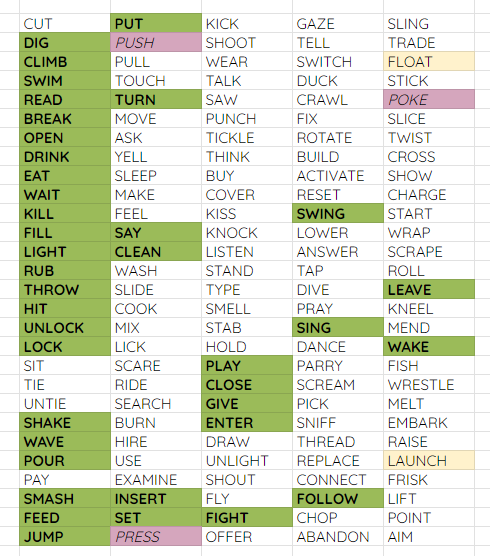
…and hit paydirt with GIVE.
This is a large rectangular room that was used as an office by the prison warden. Obvious exits lead east and north.
A large dog with a spiked collar is sitting here. He looks like he might bite if you annoyed him.
GIVE LEASH TO DOG
The dog growls ominously, but lets you clip the leash to his collar. Once leashed he seems much calmer, even friendly.
This lands the dog and leash in your inventory. The game is still pretty finicky here, as despite the two being described together, there is a difference between dropping the leash and dropping the dog. The dog will you kill you if you DROP DOG normally — that gets interpreted as also unleashing the dog. You need to DROP LEASH instead if you want to drop the dog temporarily, but fortunately for all this you don’t need to bother given the place to unleash the dog is only a few steps away:
E
You are in a small antechamber of some sort. It is simply, but attractively, decorated with nooses and pictures of famous condemned criminals. Passages lead east and west, and there is a doorway in the north wall.
E
You are in a grim looking door-lined hall. To the east is one particularly massive iron-bound door that is ajar. There is a large dark opening to the north.
A nasty looking prison guard is leaning against the cell door, and you hastily draw back, afraid he’ll see you.
DROP DOG
The dog narrows his eyes and snarls, showing ivory-white teeth. Suddenly he realizes he is free, and with a puzzled look he hesitates between you and the guard.
Finally he seems to decide that he hates the guard even more than you, and races toward him! The guard — dense, but no fool – runs like hell, with the dog snapping at his heels!
This is the other side of the starting prison cell, and you can now head north to snag a gold nugget, one of the other treasures.
With the dog out of the way, you can get in the warden’s office, described as a TREASURE TROVE in the room name.
This is the warden’s office.
N
This small square stone room was used to store the warden’s treasures; particularly the things he took away from prisoners. The only exit is a dark doorway that leads south.
This is where the black figure’s stolen loot goes to. (The figure is, as Voltgloss observed from the comments, The Persian, usually cut or merged with other characters for movie versions, although he shows up in the 1925 silent as the Inspector Ledoux.) Just like classic Adventure, after you have items stolen a chest appears with the trove as well, and taking the chest away from the trove causes the theft to stop altogether. On my “final run” I had nearly all my treasures stolen. It was easier than managing the inventory limit, to be honest, and only took to making transfers from the trove back to the wharf (the final deposit place of loot) near the very end. I never considered this as a strategy for original Adventure because the Pirate area in the maze is inconvenient to get to, and the Pirate is less persistent than the Persian is about filching things.
There is a lovely little chest here, full of jewelry.
My next moment of enlightenment was also a little meta. It went back to a portion of the game I thought I had already mapped and resolved, a storm drain with one treasure.
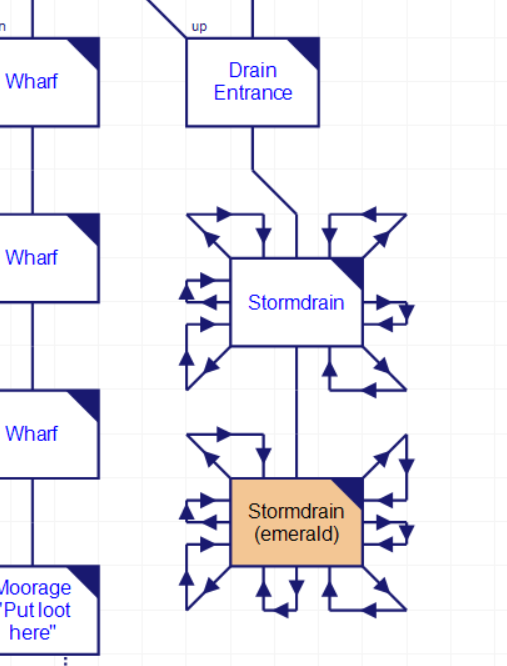
However, when I tried to go back to the area (on another run-through) I got stuck, and despite going north many, many, many times I was not able to get out with the emerald. Given the fact I did nothing special the first time, and none of the items I was carrying seemed to affect the area, I tried again and managed to get out. It simply is random, and the kind of random that one player (me the first time through) might luck through at first, but another player (me on the second) might roll unlucky 25 times in a row. I never worked out the actual percentage chance of escape, but if it’s, say, 10%, that means there’s an 11% chance that you could get unlucky 25 times in a row.
You are in the stormdrain.
N
You are in the stormdrain.
N
You are in the stormdrain.
N
You are in the stormdrain.
N
You are in the stormdrain.
N
You are in the stormdrain.
N
You are in the stormdrain.
N
You are in the stormdrain.
So, going back to the “mazes” I couldn’t get out of as they seemed to be single-room (the Catacombs and the Living Forest), I tested the theory I was just getting unlucky and kept trying to get out. The catacombs follows this theory exactly, so I found a “jeweled idol” and was able to escape the way I came.
There are thousands of strange twisted trees all around you, and oddly dressed people are running back and forth among them. The forest is there wherever you look, endless, frightening.
The Living Forest I was merely able to leave, so I knew I was missing something. I especially knew I was missing something because of this message:
BREAK MIRROR
The Magic Forest is axe-proof, bullet-proof, and maybe even Adventurer-proof. Your attack has no effect.
The mirror isn’t described in the room, but I was clearly presuming right that one was there. I thought to SING (one of the verbs off my list) but no dice:
“The sun shines bright on Pretty Red wing …”
I practice in front of the mirror every morning!
I ended up needing to check hints from Exemptus. There’s some “sheetmusic” I already used to play on an organ and open a secret passage, but apparently it also counts as vocal music if you’re holding it when you sing at the Forest.
It’s a toccata of some sort … “Don Juan Triumphant.”
SING
Your high note shatters the mirrors into a thousand pieces!
WOW, you really HAVE got a voice that shatters glass!
LOOK
You are in the Magic Forest.
A litter of broken glass covers the floor. You can see passages leading north, south, and east.
One solitary iron tree stands in the middle of the room.
To the south there’s a “tiny brass cricket” and I admit I had to check hints here again. Despite no indication otherwise you can READ it.
There was engraving on its back, but most of it is worn away. The only readable letters are “-UM-“.
This suggests you can JUMP, which warps you to a room with a ruby, yet another treasure.
You have found a tiny little room painted all in green. Big gold letters on one wall say “JUMP ROOM”. A steep narrow tunnel leads down to the west. If you go down, you will not be able to come back up.
There is a wonderful ruby here, carved to look like a cricket.
My only obstacles that remained were the two types of rats, the little ones and the big one. For the little ones, I hadn’t tried the cheese yet (I tried it on the big rat but just hadn’t gotten around to testing it on the others):
The mice eat the cheese a nibble at a time. They seem a lot friendlier now that they’ve been fed.
This yields a pretty heavy “Russian urn” and you have to be careful because getting back to the opera house requires climbing down a fragile rope ladder, and if you’re carrying too much it breaks.
With that resolved I technically had every single treasure. The big rat doesn’t block anything, the area it leads to you has alternate routes, but I looked up what to do:
A giant rat, easily eight feet high, bares its sharp front teeth, twitches its whiskers, and refuses to let you go by.
kill rat
Oh, sure! By yelling “BOO” I suppose?
yell boo
The giant rat looks startled, shocked, and keels over. I guess the poor thing had a bad heart.
Once the hypothetical came up the answer was easy; I hadn’t thought to KILL RAT. The game otherwise emphasizes the essential uselessness of the verb so it wasn’t at the forefront of my mind.
The theoretical question is a lot easier than Crowther/Woods asking if you are sure you want to engage in fisticuffs with a dragon. You’re still engaging in the parser here in the same way you’ve always done, you don’t have to switch modes and imagine it is possible to interact with the hypothetical narrator. Additionally, for someone who has trouble, the puzzle is genuinely completely optional.

Passing through the room marked in red (with the rat) lets you access the “Southwest Shore”, but there are multiple ways to arrive at the same place, most of them very straightforward.
I still must have missed some kind of puzzle (or maybe I was playing too slow and number of turns matters?) because I didn’t get the full spread of points. After you drop the last treasure at the wharf you just need to wait.
There is a strange idol here, covered with jewels.
(etc, some treasures skipped, you need to drop the white scarf before a jade horse or the jade shatters)
There is a rather dusty — but valuable! — tiara here.
There’s a wonderful little marble statue, signed by someone named “Picasso,” standing here.
There’s a gold nugget, off of a watch fob, here.
There is a delicate white silk scarf here.
A small gold ring lies gleaming on the floor.
WAIT
There is a sudden roaring sound as the motor of the launch comes to life. Hurriedly, you cast off the single mooring rope. The launch races off across the sea and finally comes to rest on a lovely, idylic beach. The local inhabitants all crowd around to celebrate your arrival, and proclaim National Adventurer Day, especially in your honor!
Your final score is 321.
You need 14 more points to reach the next higher rating.
You have become a Junior Grandmaster!
I’ve been puzzling over if there’s some sort of real story here with consistent lore, or if the author decided to tag what she thought were neat elements of the Phantom of the Opera story. There certainly seems to be some kind of logic:
- we know from the dive mention of computers that we’re referring to at least the 1970s, 1960s at latest
- there are a number of very ancient things, like a “yellowing program” from the 19th century, that indicates everyone involved ought to be dead
- yet we have someone who appears to be the Persian and a protagonist who is the Phantom
- we also have a single guard who is guarding our protagonist at the start
The timeline suggests that Erik (the Phantom) is too old to be the same Phantom.
There is a strange old prison near here, long abandoned except for a few caretakers, and some half-mad vagrants. A few people say that the prison is haunted by some sort of ghost, and that it guards some fabulous treasure. A lot of people have gone to search the old place, and have never been seen again.
Are we some sort of undead? Like an actual ghost? All previous renditions (that I know of) have Erik be a man, just a deformed one, but I could easily see a different take given we live in a coffin. At least the terror of the old prison and opera house would keep people in the waterfront town from filching the treasure lying around, but I’m unclear if we have been imprisoned a very long time, only to now initiate our revenge, or if this is recent events (why the loss of memory then, though)?
We do get a bonus point if we are holding a photo of Christine when the boat picks us up.
I still thought the lore was effective; unlike Dr. Who Adventure, this leveraged the “fan-fiction shorthand” well to make particular elements much more suggestive than they might otherwise be. I especially liked being able to teleport directly from the location the treasure gets stashed at to the private box reserved for the Ghost.
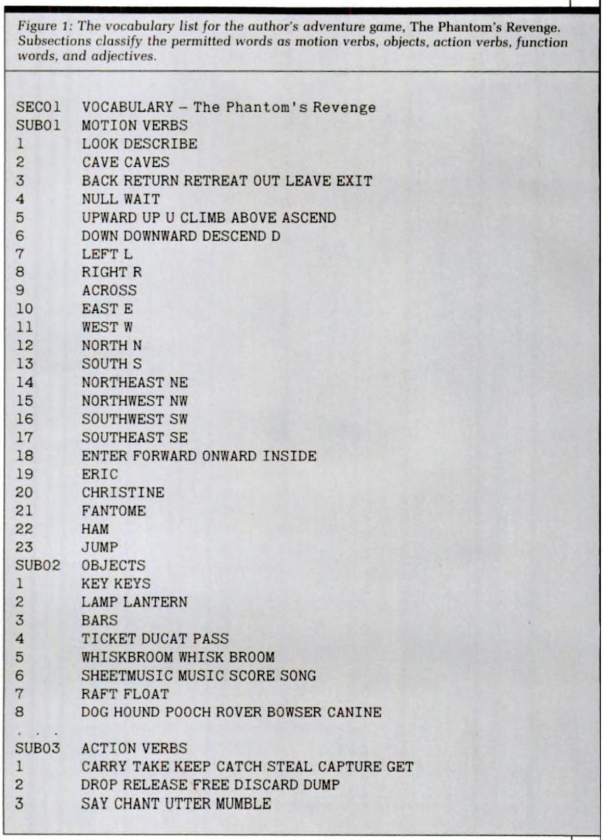
From the Girard article Do-It-Yourself Adventure. CHRISTINE is listed as a movement verb but I never found out where it gets used.
This was very tightly constrained via the Adventure framework. Dian even mentions in the article above
My own adventure games are built from two basic parts: the driver program and the text files or “script.” The script contains all of the vocabulary words that the driver recognizes, plus the object and place descriptions. There is also a builder program that converts the text in the script to machine-readable tables. Because the games are script-driven. I can build 70 to 80 percent of a new game without ever touching the actual program source code.
which can suggest something like the Scott Adams interpreter, but also suggests to me that the game has to be a treasure hunt and is limited in movable-characters to dwarf and pirate analogues. Still, it’s about the best game this kind of paint-over could attain.
I worry about future games with the same engine branching out, but we need to wait until 1983 anyway until we get there. Coming up next we’ve got two more prison escapes (short ones), two 1982 games written by people who comment on this blog, and finally an incredibly difficult game based on a British TV show where the TV show itself involves playing adventure games.
(This is a direct continuation of my prior posts on this game.)
In addition to Norell having a port of Adventure to DOS, as mentioned in the thread here, Chuck Crayne also made an entirely different CP/M port of Adventure under the label California Digital Engineering. It’s a regular port with 350 points.

Based on investigation in that thread there’s no obvious hints that parts of the code were re-used for the original Crayne games, but it’s useful to see yet another connection. Even if the DOS engine was made “from scratch” deep familiarity with the original engine surely had some influence.
Weirdly, it is possible The Phantom’s Revenge is also making yet another Adventure-port reference, this time to Gordon Letwin’s port (originally Heathkit, and eventually the TRS-80 game Microsoft Adventure) but I’ll be getting to that.
My progress didn’t feel like “solving puzzles” technically even though I marked some of the puzzles off my previous list. Nobody thinks of the keys in original DOOM as being “puzzles” — there’s a blue door, you find a blue key, now you can open it. Similarly, here there were items I found that defeated obstacles where the use was 100% clear, the hard part was finding the item in the first place. The gating was by geographic-discovery as opposed to ratiocinating about a puzzle-dilemma.
My gameplay loop hence has felt different than my standard adventure playthrough. As illustration, here’s part of my map as I left off last time:

This is at the prison area (the YNGVI room is up on top) and some of the rooms have already been marked; this mark means I have checked north, south, east, west, northeast, northwest, southeast, southwest, up, and down, and made sure I haven’t missed any exits. The room descriptions have mostly been nice about listing all exits, but since my last session I’ve discovered one quite intentional deviation — and sometimes I just misread stuff — so this kind of care is necessary for play.
The “Dungeon” for example, I poked in and out of quite quickly on my last pass, but I had not marked it yet so I knew it still needed checking.
A sense of horror fills you as you realize you are in an old torture chamber. There is a rack, with tongs and braziers. One doorway leads west, and a dark opening is to the south.
The door of the iron maiden is open, showing a dark path that leads north.
S
You are wandering through the rat-infested dungeon.
The dungeon doesn’t say anything about exits, and in fact all exits work: this is another small maze.
This is the dungeon.
E
This is the dungeon.
S
You are wandering through the rat-infested dungeon.
The whole area is full of dust and cobwebs.
OK, this is technically a puzzle, but it is heavily telegraphed: I was carrying around a whiskbroom with nothing to show for it yet, and one of the dungeon rooms quite specifically talks about dust and cobwebs.
Your efforts raise a thick cloud of … achoo! … dust, and dislodge a trapdoor that swings open to show a dark opening in the … achoo! ACHOO! … floor.
D
You have found your way into an ancient crypt. The stones under your feet are worn, as if by the footsteps of people long dead, and the whole area seems old beyond belief. A narrow flight of stone steps leads up to a dark opening in the ceiling, and there is an equally dark arched doorway to the east.
Again, in a general gameplay sense, while this was a new discovery in the sense of a “wanderer explorer”, it didn’t feel like I had resolved some tricky gate. I think a good comparison is an RPG where you’re finding some new path in a dungeon, but not doing any work to get there other than look carefully. It still can be satisfying gameplay but it doesn’t happen as much with modern game density (and the implicit idea that a puzzle that isn’t really a puzzle is a bad thing).
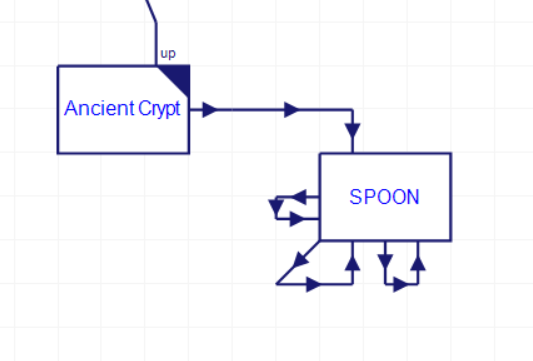
Here’s another snapshot of map creation in progress. I tested every exit from the Crypt and marked it as “done”; then I moved on the room to the east, some Catacombs (“You are in a vast and silent catacomb, lined with the tombs of un-named, ancient dead.”) and found it was another maze, so I dropped an item (my trusty spoon, used at the start of the game for digging a whole and now my opening maze placeholder). So far on the image above I’ve tested west, southwest, and south, finding it to be looping.
Continuing my way around, I found every exit to be looping. In such a case I’ve also been testing my various magic words: FANTOME, HAM, and YNGVI. I’m not expecting any of them to work as they already have their locations, but I want to be careful about false assumptions. I’ve also found, by accident, that CHRISTINE is another transport-word, but I don’t know where it goes (“You can’t go in that direction, sorry” — like FANTOM and so forth do in the wrong place).
I don’t know yet if this means if the Catacombs is a puzzle that needs resolving, or just a softlock we’re supposed to avoid. I’ve also been stalled such in a Magic Forest quite near the Phantom’s “coffin” residence for similar reasons, although going north or south causes a unique effect:
There are thousands of strange twisted trees all around you, and oddly dressed people are running back and forth among them. The forest is there wherever you look, endless, frightening.
There is a tattered page of sheetmusic lying here.
D
You are in the Magic Forest.
There are thousands of strange twisted trees all around you, and oddly dressed people are running back and forth among them. The forest is there wherever you look, endless, frightening.
There is a tattered page of sheetmusic lying here.
N
With a sickening “THUD!” you hit your head against the cold, hard surface of a Magic Forest tree.
You are in the Magic Forest.
There are thousands of strange twisted trees all around you, and oddly dressed people are running back and forth among them. The forest is there wherever you look, endless, frightening.
There is a tattered page of sheetmusic lying here.
It could be that the Magic Forest is a puzzle and the Catacombs is a softlock, or they’re both softlocked, or they’re both intended as puzzles. I don’t know yet. It was time to move on (via a saved game) and explore more rooms, though.
The Warden’s Office have exits listed to the north and east, but I hadn’t tested them yet to a guard dog. (“A large dog with a spiked collar is sitting here. He looks like he might bite if you annoyed him.”) Incidentally, trying to attach the leash the dog says “there isn’t any switch on it” so either I’m going up the wrong tree or I am genuinely missing an item. It turns out only north is blocked by the dog, and east leads to a whole new area, so I kept mapping:

This is mostly of a “warden’s house”. You’ll notice not all rooms are marked; this means I haven’t done the thorough-exit check yet. In the Antechamber, I hit gold and hadn’t bothered to loop back yet:
This is a large rectangular room that was used as an office by the prison warden. Obvious exits lead east and north.
A large dog with a spiked collar is sitting here. He looks like he might bite if you annoyed him.
E
You are in a small antechamber of some sort. It is simply, but attractively, decorated with nooses and pictures of famous condemned criminals. Passages lead east and west, and there is a doorway in the north wall.
SE
You have found a secret passage that twists around through the prison walls. There are dark, forbidding openings to the east and northwest.
The game quite explicitly left the exit to the southeast unmentioned. This means my test-all-exits has not been in vain but it also means, since there’s at least one, I have to keep going. From an author’s perspective, sometimes it is tempting to violate some gameplay norm once for effect, with the knowledge that it only happens once; from the player’s perspective, they don’t know if the gameplay norm will be violated in the future, so they have to imagine it can occur an infinite number of times!
this is a nice comfortable study. There is a fireplace, some comfortable chairs, and the walls are lined with books. There are some rather plain doorways to the north and east.
There is a beautifully carved jade horse here.
E
You are in the warden’s bedroom. It is rather plain, and the only doorway leads west.
There is a document lying on the floor marked “ONE ONLY”
This document solves another puzzle, the guarded gate. It technically is slightly ambiguous (so requires a little thought process) but in practice I knew immediately where it had to go, so the effect was more like finding the blue DOOM key.
The warden house area incidentally has a newspaper clipping which help get through yet another door:
This is the east end of the prison exercise yard. There are high stone walls all around you.
There is a yellowed newspaper clipping lying here.
GET CLIPPING
Okay.
READ CLIPPING
“Operatic soprano Mille. Christine Daae has the perfect combination for a star: a magnificent voice coupled with a perfect face and figure. The beautious Mlle. Daae, born 112371, shines like a diamond on the stage of the Paris Opera.”
The oddly-given date suggested I should use the number at the vault in the office, and indeed it works (you just type the number like it was a magic word), although the only item in the vault is another treasure (a “lovely pink diamond”).
I shouldn’t be quite so blasé about the puzzles because there were two “obvious” puzzles I didn’t recognize right away. In one case I mentioned both parts in my last post: a card that said “Joe sent me” and a “dive” that wouldn’t let me in the back. By writing my post and reading it over I realized they had to go together.
This is obviously a low dive. Big burly men in black shirts, fallen women, and computer freaks of all sorts line the dirty bar. A crazed young man is frantically pushing buttons on a big machine with bright blinking lights. There is a small, inconspicuous door in the east wall.
E
This is a well-concealed backroom, filled with strange sounds. The air is heavy with odorous smoke. Cheap chairs line the walls, and people of all sexes lean back listlessly with sheets of paper in their hands and odd dark-screened devices in front of them. Some are muttering to themselves, others laughing.
There’s a very expensive Persian rug on the floor.
There’s no acknowledgement the item even does the solving, someone might run into the Parallel Universe Problem and solve it by accident. Also, that second room is described as a HACKER’S DEN in the title description, which strongly suggests to me another room specifically in Microsoft Adventure:
YOU ARE IN A STRANGE ROOM WHOSE ENTRANCE WAS HIDDEN BEHIND THE CURTAINS. THE FLOOR IS CARPETED, THE WALLS ARE RUBBER, THE ROOM IS STREWN WITH PAPERS, LISTINGS, BOOKS, AND HALF-EMPTY DR. PEPPER BOTTLES. THE DOOR IN THE SOUTH WALL IS ALMOST COVERED BY A LARGE COLOUR POSTER OF A NUDE CRAY-1 SUPERCOMPUTER.
A SIGN ON THE WALL SAYS, “SOFTWARE DEN.”
THE SOFTWARE WIZARD IS NOWHERE TO BE SEEN.
THERE ARE MANY COMPUTERS HERE, MICROS, MINIS, AND MAXIS.
This might just be coincidence; there is no scene similar to the Microsoft game where taking a computer causes you to get punished.
The second “obvious” puzzle I missed was involving the “big round black thing, with a hole in it”, and to be fair that description is vague. However, if you grab it and take INVENTORY you find it is actually a “LARGE BLACK INNER TUBE” — in other words, it lets you travel along the river. I had already traveled along the river but didn’t realize it was helping! I did have one other river location I had missed earlier (before I had the tube) leading me to a new area:
There seems to be no end to the river. Your eyes rest in fascination on the debris that floats along beside you. There is a narrow dark niche cut into the east bank here.
E
This is a dark niche in the east bank of the river. An ominous vaulted opening leads off to the east, and the river rushes by on the west.
E
You are moving along the watery path of an ancient Roman aquaduct. A dark vaulted opening leads west, and there is a rather ornate mosaic-covered archway to the south.
S
You are standing in the vast hall of an ancient Roman Bath. Everywhere you turn your lamp you see fabulous mosaics of sea creatures and lovely naked nymphs on the walls. There is a large arched opening in the north wall, and a hole in the floor where the tiles caved in. If you go down, you won’t be able to come back up.
There’s a piece of rare coral here, carved into a mermaid.
Still, even with this moment of realization this still felt more like expanding the map in an RPG (without puzzle-blockers) than in an adventure. I did technically solve two other things: I played music at an organ and found a new treasure…
There is a magnificent pipe organ against the south wall. Its gleaming pipes, pedals, and manuals seem to fill the room.
PLAY ORGAN
The organ swings slowly out from the wall, revealing a dark opening in the south wall.
…and I tried digging at the beach and found a pearl necklace…
There is a small patch of sand here, and the seawater laps gently back and forth just south of you.
DIG
Your digging uncovers a lovely pearl necklace!
…but really, I am only just now filling in the last pieces of the jigsaw puzzle’s borders before starting on the hard work of the “stumpers” of the game. My updated obstacle list:
obstacles: single large rat, multiple rats, guard dog, going west at starting prison cell, the magic forest “maze”, the catacombs “maze”, figuring out where CHRISTINE gets used
(Oh, I was able to get to the prison cell from the other side but I still get stopped by a guard, and there’s clearly a room there I need to see. So it’s the same puzzle, now just I have two ways to get to the same place.)
(Previous post on this game here.)
I need to dig back in the history bin in order to contextualize some design choices made with The Phantom’s Revenge, and one particularly wild moment that threw me aback.
I need to talk about Jim Gillogly, Walt Bilofsky, and Software Toolworks.

The above clip (Softalk, December 1982) I already used in my discussion of The Hermit’s Secret, but I left out talking about The Original Adventure, which was published before either Girard game. What makes its presence here something of a puzzle is that the Gillogly/Bilofsky edition — which adds several puzzles and an endgame — was first published by an entirely different company, Software Toolworks.
In 1980, Walter Bilofsky was working at RAND in Santa Monica, and had a Heathkit H89 that he assembled out of a kit as a home computer. With his computer he wrote an enhanced C compiler (rewriting an earlier compiler called Small C made by Ron Cain), and started selling it for $40. Bilofsky originally wanted to sell the product for $80 and wanted to split profits with Cain, but Cain was not interested (early hacker ethos, he just wanted to spread the gospel of C) so he halved the price instead.
This was the start of Software Toolworks, and in early 1982 Walter started selling a version of Adventure.1 Just like Small C, this was based on pre-existing code, this time from 1977 by Gillogly (in C) although the Software Toolworks version adds three treasures and a new endgame. This means, yes, I should go back and play it at some point since it isn’t just a port. It incidentally is the one commercial version which eventually (in later ports) got an official endorsement from Crowther and Woods and started paying them royalties.
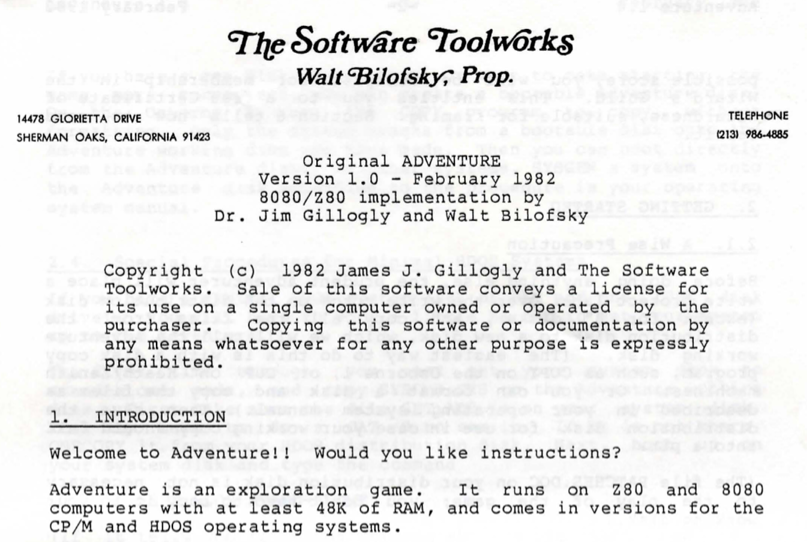
From the Museum of Computer Adventure Games.
The software was compiled for the CP/M operating system and HDOS and ran on Bilofsky’s beloved H89; it was not originally sold for the DOS operating system but my guess is the Norrell version (which we do not have) was arranged so a DOS version was available. This isn’t an enormous technical leap (the operating systems are fairly close together) but it means that Mel Norrell had C source code at hand that was a quite direct port.
This program was originally developed by Willie Crowther. Most of the features of the current program were added by Don Woods. The UNIX version was implemented in C by Jim Gillogly, and expanded and moved to the 8080/Z80 by Walt Bilofsky.
And by quite direct, I mean it even includes a feature left out of some versions, which is you can enter commands in the wrong order. That is, LIGHT LAMP works, but so does LAMP LIGHT. This tends to only be true of derivatives of Crowther/Woods Adventure; even parsers that recognize verbs and nouns like Avon insist on them being in the right order.
Guess which game also allows verbs and nouns to be given out of order?
There is a rather battered old spoon on the floor.
SPOON GET
Okay.
It’s not exact one-to-one code — for example, the weird “blank response” verbs aren’t broken in the Software Toolworks Adventure — but I feel like that the engine here had to have been created by directly eyeballing what came out of Adventure if not at least cribbed in part directly.
This explains, for example, why there are still people functionally equivalent to the dwarves and pirate in this game, despite it being Girard’s second published game. It comes off as a “re-skin” and the way puzzles work — mainly by not letting the player go through a particular exit — also gives a similar feel.
The maniac(s) — that I saw last time and had trouble throwing an axe at — serve as the dwarves. I had been typing THROW AXE, but I needed THROW AXE AT MANIAC (again, not exactly like original Adventure).
There is a nasty-looking maniac here, eyeing you.
One sharply honed knife is thrown at you.
It missed!
This is the middle of the stage. Far above you can see huge flats of scenery held in place by guy wires and ropes. Just in front of you is the orchestra pit, and beyond that stretches an endless sea of seats, upholstered in red plush. There is a small curtained exit to the east.
THROW AXE AT MANIAC
You attack a maniac, but he moves nimbly out of the way.
TAKE AXE
Okay.
THROW AXE AT MANIAC
You killed a maniac! An incredible giant rat lumbers out of the shadows, gobbles up the corpse, and leaves squealing.
Alternately, a ghoul may come out to drag out the carcass. The ghouls also serve as the games “grues” or “pits” and will get you if you wander in the dark.
The pirate, on the other hand, is a “tall dark man”.
There is the sound of heavy breathing from the darkness behind you.
This is a large dressing room obviously intended for a star. It has a pretty dressing table, and a screen covered with roses, cherubs, and an incredible collection of love letters. They are all addressed to someone named Christine. The only doorway is in the east wall.
There is a rather dusty — but valuable! — tiara here.
GET TIARA
Okay.
E
A tall dark man wearing an astrakan hat and evening clothes slides slyly out of the darkness, comments “I’ll just relieve you of that,” and lightly snatches up your treasure before vanishing into the shadows.
The references to Christine made me highly suspect we were dealing with this fellow:

Returning to my main point: you would think the strong restriction mechanically to Adventure would make any notion of a plot twist impossible, but The Phantom’s Revenge does something to pull it off anyway. It feels a bit like “engine abuse” akin to building a tower defense game in a Baba is You level but that just made me even more impressed.
So, returning to the game’s content itself, here’s a meta-map of the environs.
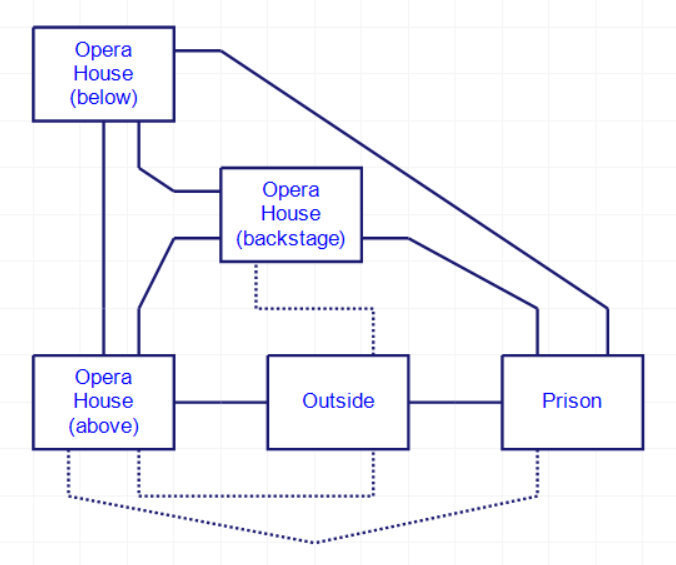
You’ll notice lots of dotted lines. Those are for the magic words that allow fast travel. They tend to be (or at least have tended so far to be) easy to find. As Andrew Plotkin pointed out in the comments, we saw one with the phrase “Yngvi is a louse” which originated in the short story The Roaring Trumpet and immediately became a meme in the sci-fi/fantasy community.2

Picture from The Roaring Trumpet as it first appeared in the fantasy fiction publication Unknown, May 1940. Story by L. Sprague de Camp and Fletcher Pratt; illustrators for this issue were Cartier, Hewitt, Isip and Schneemann.
“Ham” is a little more indirect, but still obvious:
You are in a small alley, walking under a lovely blue sky. You can hear some traffic noises to the south. There is a weatherbeaten door to the north that says “Deliveries.”
There is some rudely scrawled grafitti on the wall.
READ GRAFITTI
It says “Every ham wants center stage,” and looks like it was put on in a hurry with a spray can.
HAM
It is now pitch dark. If you go on you’ll probably be eaten by a ghoul.
LIGHT LAMP
The lamp is now on.
This is the middle of the stage. Far above you can see huge flats of scenery held in place by guy wires and ropes. Just in front of you is the orchestra pit, and beyond that stretches an endless sea of seats, upholstered in red plush.
There is a small curtained exit to the east.
More ominous is “FANTOME”.
You are at the south end of the wharf. There is a moorage of some kind just south of you, with a broad harbor beyond. Far off on the horizon there is a small island with a grim building on it that fills you with indescribable horror.
S
You are standing in a rather large motor launch that is moored to the end of the wharf. There is a neatly lettered sign in the stern that says “Put loot here.” The name on the side of the boat is FANTOME.
FANTOME
You are in a private theatre box, furnished with two red and gold chairs. A small sign on the wall says “Reserved for the Ghost.” The whole room is draped in red velvet except to the east, where a gap in the curtains lets you see the stage. The only exit leads northeast.
There is a tattered page of sheetmusic lying here.
As the “put loot here” message implies, I did find the place where the loot goes, and you have the typical satisfaction of a score increase when making the deposit. What I found puzzle is the location. Hermit’s had you deposit at a spaceship, and leaving the planet seemed like an appropriate end to the game. Here, we are leaving our ominous prison/opera house to an even spookier island filled with “indescribable horror”?
There is some sense to this, which I’ll be getting to. But at least at that moment I was quite puzzled.
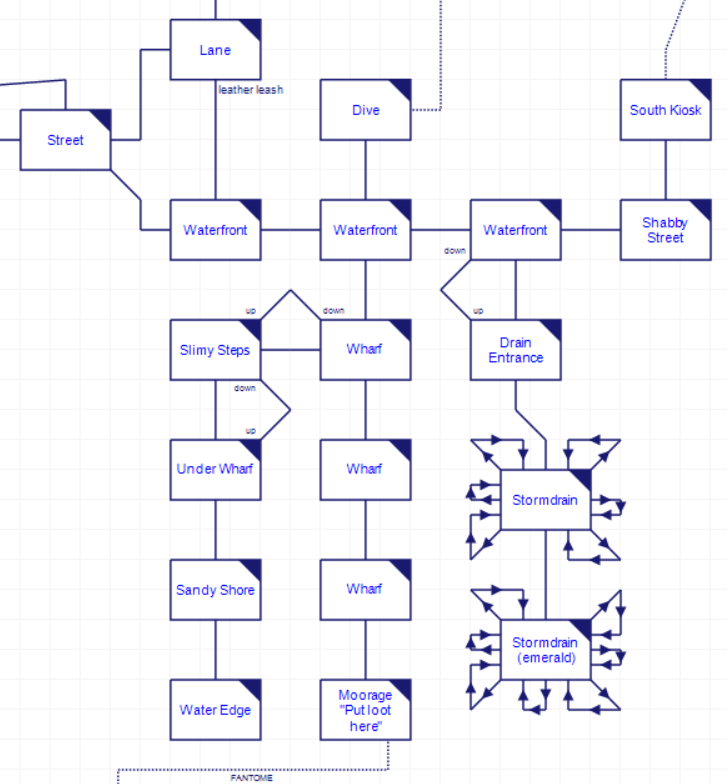
I’m not going to give all my maps yet — they’re definitely works in progress — but the picture above shows part of outside.
You are in the middle of a short section of waterfront. The entrance to some sort of low dive opens to the north. South of you the boardwalk stretches out into an old creosoted wharf, and you can hear the roar of the surf.
N
This is obviously a low dive. Big burly men in black shirts, fallen women, and computer freaks of all sorts line the dirty bar. A crazed young man is frantically pushing buttons on a big machine with bright blinking lights. There is a small, inconspicuous door in the east wall.
The presence of people, that is, normal people walking around, not maniacs throwing knives in the dark — makes for some interesting spice to the atmosphere. There are people here living (and playing some manner of arcade game) but surrounded by a decaying opera house, prison, and distant creepy island. None of them talk, but this feels appropriate for the decay.
Well, mostly none — if you try to go east, a bouncer stops you, which is one of my unsolved puzzles. Also nearby there’s a “guard kiosk” to the prison which requires a pass and I have no pass.
South of the dive is the “loot here” place, and underneath there is a beach which serves no purpose I could find. Mind you I waited many terms, being burned by both Zork III and Avon requiring you to hang out on a beach hoping something shows up.
There is a small patch of sand here, and the seawater laps gently back and forth just south of you.
S
This is where the ocean meets the land. The waves roll in and out in hypnotic sequence.
The prison area has a bunch of curious items lying around (like keys, a whiskbroom, and a “round black thing” where you get no further description); I was able to use the keys to unlock an “iron maiden” which opened a secret area blocked by a dog. Going in a different direction led to a river where I was able to ride a grate (?) down a river before making it to a mysterious underground lake.
You are at the mouth of a large river that runs here from the north. South of you it feeds into a large underground lake.
S
This is the north east shore of a peaceful underground lake. You can see only water and the massive stone wall enclosing it.
The underground lake connects to the backstage rooms of the opera house, including an area blocked by many rats and an area blocked by one giant rat.
This is a rather dirty tunnel that slopes up to the south.
It turns into some sort of gravel covered area to the north.
A giant rat, easily eight feet high, bares its sharp front teeth, twitches its whiskers, and refuses to let you go by.
FEED RAT
The rat gobbles up the cheese, and then starts to eye you as a possible second course.
The upper portion of the opera house has some seats (a small maze, a gold ring is there), an office with a safe (which I haven’t opened) and, weirdly enough, a Gutenberg bible as one of the treasures.
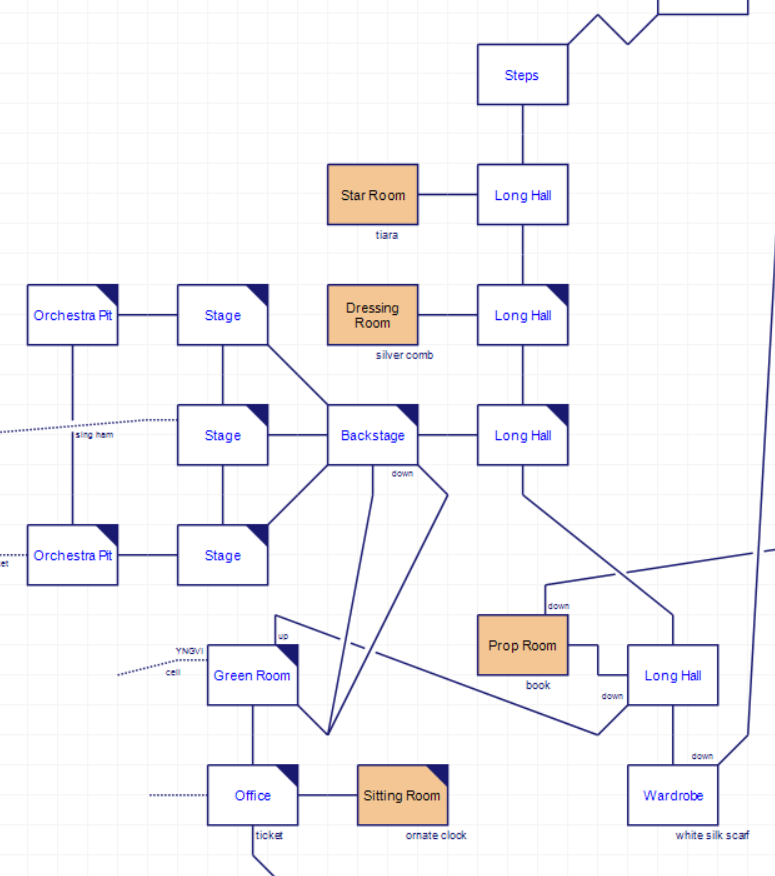
Treasures marked in color.
As the pictures above imply, a good number of the treasures tend to be just lying around (again Adventure-style) although managing to get them all to safety (the wharf) without theft is somewhat tricky to coordinate (just like Adventure) and the lamp is running out of power at the same time and must be conserved (also just like Adventure).
The bit that wasn’t just like Adventure is one of the last pieces I mapped:
This is a small, rather oppressive drawing room. It is decorated in black, with a few touches of crimson and silver. Dark forbidding doorways lead out of all four walls.
There is a framed photograph of a lovely woman here.
N
As you walk into this black draped room, and see the great ebony coffin that is its only feature, you feel dizzy and suddenly faint. Then, with a rush of exultation, memory returns to you! This is your home, your secret lair. YOU ARE THE PHANTOM!
While the situation still doesn’t completely make sense to me, multiple pieces clicked: the reason we started in prison, the ambiguous opening, and most importantly the reason why we’d be gathering treasures to take to a spooky island — I assume to enact the “revenge” that we are seeking. I am curious if more plot points, I suppose again via room description, get dispensed along the way.
The curious design aspect here is that while I found the above revelation pretty deep in my wanderings, it would have been possible to discover it early. It wouldn’t have undermined things, exactly, but it was a more effective moment when I had the oddness of the situation hanging as I was making a map. I admit I didn’t trust it would go anywhere — The Hermit’s Secret never really did — which is part of why it took me by surprise.
So the man in black is someone else entirely. Since I haven’t found his lair I don’t want to speculate yet as to his identity (and of course the game might not give a satisfying answer).
A list of everything I’ve found so far:
treasures found: silver comb, tiara, ornate clock, framed photograph, russian egg, emerald, book, ivory bracelet, platinum brooch, gold ring, opera program
items found: spoon, cheese, ticket, white silk scarf, round black thing, whiskbroom, leash, keys, musicsheet, little card (“Joe sent me”)
obstacles: single large rat, multiple rats, guard dog, safe, dive, guard station, going west at starting prison cell, and I still need to map out a “magic forest” near the coffin
Yes, I should try the leash on the dog, I’ll get to it, but I suspect I’ll need to do something else to make the dog peaceful first. This is a game where coming up with the initial map is overwhelming and solving puzzles really has to come after already spending several hours just soaking up the locations.

The seats maze just for reference.
1. The copy at the Museum of Adventure Games is marked 1.0 and seems to be the earliest. It is dated February 1982. Even though some sources say it was released in 1981 I’m sticking with 1982.↩
2. Fortunately the air was warm enough so Shea didn’t mind the loss of his garments from a thermal point of view. Around them the dungeon was silent, save for a drip of water somewhere and the occasional rustle of a prisoner in his cell. Across from Shea there was a clank of chains. An emaciated figure with a wildly disordered beard shuffled up to the bars and screamed, “Yngvi is a louse!” and shuffled back again.
“What means he?” Heimdall called out.
From the right came a muffled answer: “None knows. He says it every hour. He is mad, as you will be.”
“Cheerful place,” remarked Shea.↩
We last saw Dian Gerard (or Dian Crayne, or J. D. Crayne) with The Hermit’s Secret, as published by Norell Data Systems; she followed up the same year with The Phantom’s Revenge.
Treasures, puzzles, and danger are waiting for you. Over a hundred rooms, a fascinating and challenging adventure.
For my general history see my Hermit’s Secret post, but I have two pieces of news regarding Dian to add:
1.) Monster Rally, previously a lost game, has been unearthed. (Described as: “a large text only horror/fantasy epic weighing it at circa 300 locations”.) We’ll make it there in 1983. Oddly, the rescued copy is credited to Dian’s husband, Chuck Crayne, and despite all the games of this line being credited to Dian, he may have done some uncredited collaboration on the others. They at least worked together some; the pair are credited together in 1985 with the book Serious Assembler.
2.) Exemptus has investigated the game Granny’s Place — a game that lacked a name as published by Temple Software — and concluded Dian Gerard/Crayne was responsible for that game too. He goes into the reasons why in the post, but I wanted to highlight the use of encryption to “sign” the code:
The table of messages in the game files is encrypted with a 1-byte XOR operation. This is not uncommon, but guess what the value of the encryption byte is: hexadecimal DC, the initials of her name. So basically she signed the code.
Before getting into The Phantom’s Revenge, I wanted to look backwards a little at the formation of the publisher Norrell, as it explains how at least a little how what normally seems like a “utilities company” had more connection with games than it might seem at first glance. We can trace the story back to 1975 and, weirdly enough, the Sphere computer, which only lasted from 1975 to 1977.

Byte Magazine, September 1975. Ben Zotto has a long presentation here done at the Computer History Museum if you’d like to see more.
Despite the short life span of the computer, a company formed — Programma Consultants, headed by Mel Norell — producing software for the Sphere as well as a newsletter.
Our main function is to provide reasonably priced software program products to users of 6800 based machines. Specifically, we have been providing support software for the Sphere Series/300 System since June 1976.
The above statement was written in June 1977, when Sphere was already applying for Chapter 11 bankruptcy. It incidentally reports that Sphere was “in the hole” for $600,000.
While the Sphere was alive, Programma produced a replacement operating system (OS/1) and published some games, like a chess program by Chuck Crayne (that’s Dian’s husband, remember) and a “Tank War Game” by Scott Adams.
Simultaneous to this, the accountant Dave Gordon discovered computers in 1977, originally putting down payments on both a TRS-80 and a Commodore Pet; when saw an Apple II, he canceled both orders and went all-in with Apple. He scrounged (and pirated) software. According to a July 1983 profile in Softline:
From the first day he got his computer, Gordon seemed intent on acquiring every public-domain program written for the Apple. His enormous appetite for software drove him to user-group meetings, software stores, and the homes of fellow Apple owners. A hustler, a trader, a Brooklyn-turned-L.A.-bum, Gordon copied and traded software as if it were bubble-gum cards.
Gordon became friends with Norrell (no doubt due to Gordon meeting everyone in the computer community) and formed Programma International with him in 1978, expanding past Sphere computers to computers more generally. Programma became (in)famous for putting out a blizzard of software in the next two years of high and low quality. While they generally stayed associated with Apple, they went into PET, TRS-80, Atari, and the Exidy Sorceror as well.
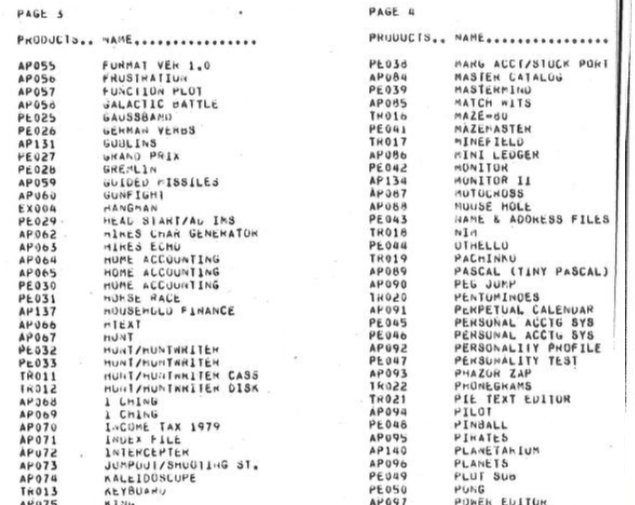
The catalog I just linked includes Disk Magic, Apple II software by Dian Girard. It sold for $25.
This utility program allows the user to examine and modify diskettes created for the Apple ][ from the physical sector level and without the limitations imposed by standard DOS commands. It is possible to determine actual remaining disk, space, release system space for program use, fix damaged files of all types, and restore some files that have been deleted. A comprehensive manual included.
The company was having trouble by late 1980 and got bought by Hayden Book Company. Gordon stayed on as a vice-president, but Gordon was soon out due to personality clashes and formed the new company Datamost.
Norrell went off to form Norrell Data Systems instead. One of their earliest products was Rocket Command for Apple II, an arcade game that looked a lot like something that would come out of Programma instead, and in fact there was some confusion about this at the time; Mel Norrell wrote in to Softline to correct them on giving credit to Programma for the game.

Just a Missile Command clone.
After this, though, the catalog essentially settled on utilities for DOS. It is nice to know that Norrell as a person (albeit under a different company) had a brief moment of massive game distribution before switching gears.
Enough wandering, let’s get into the game:
So you want to challenge the Phantom!
Would you like instructions?
yes
There is a strange old prison near here, long abandoned except for a few caretakers, and some half-mad vagrants. A few people say that the prison is haunted by some sort of ghost, and that it guards some fabulous treasure. A lot of people have gone to search the old place, and have never been seen again. If you want to explore the old place, I’ll help you all I can. Direct me with one or two words, and if you’re stuck, type INFO for general information, or HELP for some basic instructions.
This program and script were developed by Temple Software, Inc.
You are in a tiny stone cell. The only light comes from a small barred window, too high for you to reach. There is a massive iron-bound door set in the west wall. It is ajar.
Impenetrable gray stones surround you on all sides. When you look cautiously around the edge of the door you see the back of a burly uniformed guard, and hastily retreat.
There is a slightly moldy piece of cheese on the floor.
There is a rather battered old spoon on the floor.
Despite there being of plenty of room for text I feel like we’re missing some context that’d be in a manual. We’re still on a Treasure Hunt (I think) but we start stuck in a prison instead, and then need to break out before we start exploring.
Trying to just leave to the west has us stopped by the burly guard.
The guard is a little out of condition, but take it from me, he’s MEAN! You can’t get past him without the proper resources.
It’s possible we’ll reckon with him later. I would have been stuck longer but I brought out my standard verb list to test and DIG happens to be quite early:
As you dig frantically at the east wall, the stones slowly loosen! Suddenly, several of them fall to the floor, along with a bright gold ring that had been embedded in the mortar! The ring rolls across the floor and vanishes under the door – leaving you with a heap of rubble and a hole in the east wall.
The map then opens up a bit, so while the bottleneck only lasted a short while, it did serve some purpose in giving some sense of atmosphere and plot that the author’s previous game lacked.
Just for the record, I did finish my verb list:
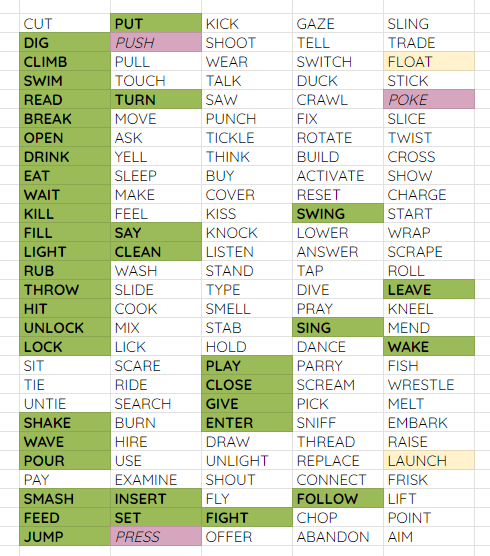
Purple items are verbs that give “blank responses”. This apparently happens with these specific verbs in other Norrell games, so it is a common codebase bug. For two of the words (FLOAT and LAUNCH) the game reacted like they were nouns instead. Notable green-marked verbs are SING, FOLLOW, and WAKE, none of which are easy to think about while in the midst of puzzle crunching.
After making the prison escape:
You force your body through a tight east-west crawl, moving along carefully on your hands and knees.
E
The tunnel you are in is dark, and you feel the floor ahead of you carefully, fearful of open pits or traps. The floor is dry, gritty, and seems to be made of great slabs of stone. There is a strong current of air coming from the southwest.
SW
You are crawling along through a dark, low ceilinged tunnel. The floor is fairly smooth here, and you can feel fine soft powder that might be dust. There is a dim light to the southwest, and an equally dim glow to the east.
SW
You are walking on a tree-lined lane, under a blue sky. West there is a busy street. As the lane curves off to the south it turns into some kind of waterfront area. There is a storm- drain opening to the north of you.
There is a strong leather leash lying here.
Knowing Girard’s last game, this is going to be a big map to tame, so I’m not going to be foolish enough to try to convey everything in one go. But a few observations based on what I’ve seen so far:
1.) This is still clearly using the “Adventure codebase” in feel, even if it isn’t literally the same code. The “dwarves” throwing axes are still in, just reskinned, in an admittedly nicely thematic way.
You have crawled into a low-ceilinged room where strange gray and green fungus covers the walls. There is a small dark opening in the northeast wall, and a slightly larger passage to the south.
A strange figure in a tattered old uniform (obviously some prison guard driven half mad by fear) lurches around a corner, throws an old fire axe at you — which misses — and then staggers off cursing into the darkness.
An old fire axe is lying nearby.
2.) Fairly early on there’s a magic word that warps you straight from some caves and prison cells over to an opera house. Using the same word in the same place wraps you back again; it gets treated as a “direction” like north or south rather than magic.
You find yourself in a vacant stone cell with doors to the north and south. Some demented soul has scratched the words “YNGVI IS A LOUSE!” on the west wall.
YNGVI
This is the Green Room of the opera house, where the performers and their friends used to gather after the show was over. There is a doorway to the south, and a passage leads upward.
S
This room seems to be the office of the opera manager. It is neatly decorated with playbills, and has a large desk and swivel chair. Doors lead out of all four walls, but the west wall is steel and has a combination lock on it.
There is an old theatre ticket here.
READ TICKET
It says “ADMIT ONE – CENTER SECTION”
3.) Exploring some abandoned cells I found a “maniac” but throwing an axe does nothing so I don’t think they’re meant as a normal hostile mob.
There is a vacant cell here, and the only exits are a doorway in the south wall, and a rather small hole in the floor.
D
There is a nasty-looking maniac here, eyeing you. This is the west end of a long east-west tunnel. A dusty passage goes south from here, and a narrow hole leads upward.
This already is more coherent than The Hermit’s Secret, and since I already know what I’m in for (big map that unites in multiple ways) I’m feeling positive about this one.
























